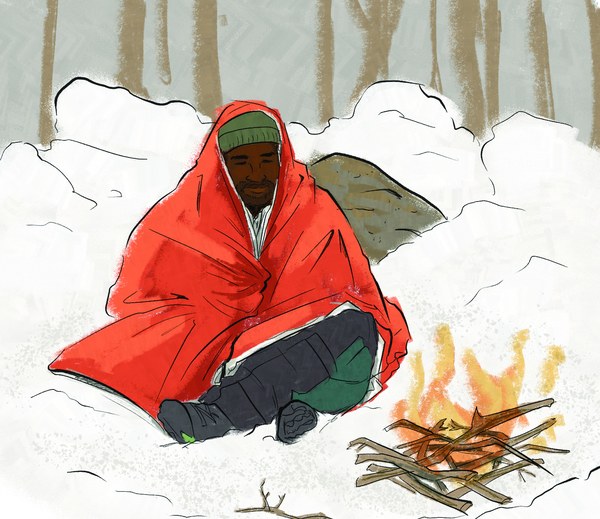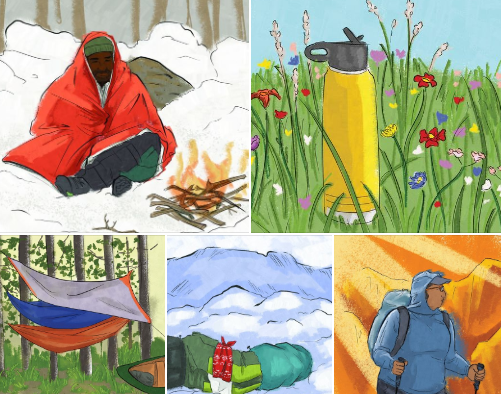
In 1974, the third edition of Mountaineering: The Freedom of the Hills was released and with it, a safety and packing system named The Ten Essentials. This year, we’re happily celebrating 50 years of The Ten Essentials minimizing risks outdoors.
Carrying The Ten Essentials ensures you can respond to unexpected emergencies in the backcountry. Essential gear includes navigation, a headlamp, sun protection, first aid, a knife, fire, shelter, extra food, extra water, and extra clothes.
Eventually, every outdoor goer is confronted with a scenario that requires The Ten Essentials. Whether we are prepared or not is up to us. Learn from stories of fellow Mountaineers about when The Ten Essentials have prevented remote emergencies, or how not carrying Essentials has sowed the seeds of high-risk recreation.
The mighty emergency blanket, by Buffy Sawyer
In the final Washington section of the Pacific Crest Trail, I entered the remote wilderness of Glacier Peak. The temperature dropped precipitously and clouds let loose. Bodies shaking, the group began to experience symptoms of hypothermia. We bailed into our tents by 2pm. The day was too cold and wet to go on. In my tent, I immediately pulled out my emergency blanket to warm up, and kept the blanket close throughout the night. The next day, I used the blanket as a "shirt-shaped" barrier to my soaked rain jacket and stayed surprisingly toasty all day. Later that evening, I used the emergency blanket as a liner between my sleeping pad and the wet tent bottom. Turns out, in an emergency there are more uses for a blanket than I originally expected. By day two, the emergency blanket gave its life to save mine.
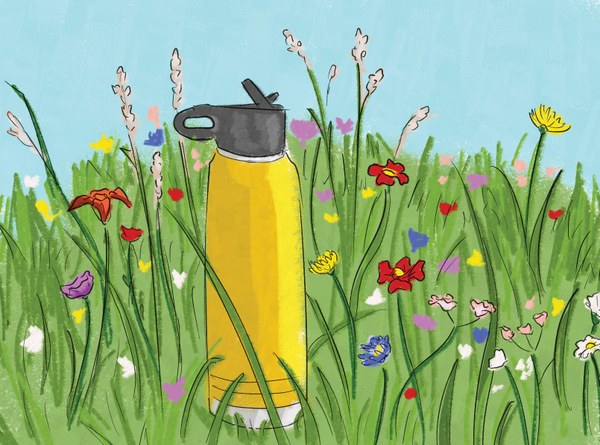
A hard lesson in hydration, by Ralph Radford
On a hot July day at Mount Rainier National Park, a friend and I set off to capture photos of wildflowers. Looking at the park map, we decided the trail to the wildflower meadow was short, and it would be best to leave extra weight behind. Grabbing our cameras and a small water bottle, we were off, leaving our extra water in the car. We made it to our destination fairly easily, though we weren’t yet satisfied with the wildflower images. Our small water bottle ran out, but we didn’t feel thirsty and in search of more wildflowers, we kept moving. As the day progressed and the air got hotter, we quickly became dehydrated. When we made the decision to turn back to the car, we were much further than we realized. Stumbling along the trail, our mouths became increasingly parched. Finally in the car, we drank all the water we could get our hands on… Our second mistake. Our dehydrated bodies couldn’t tolerate the large quantity of water, and we became sick. Too sick to drive for multiple hours. Luckily, the nausea eventually subsided and we made it home safely. No matter how small the hike may seem, always carry too much water. I promise, the extra weight pales in comparison.
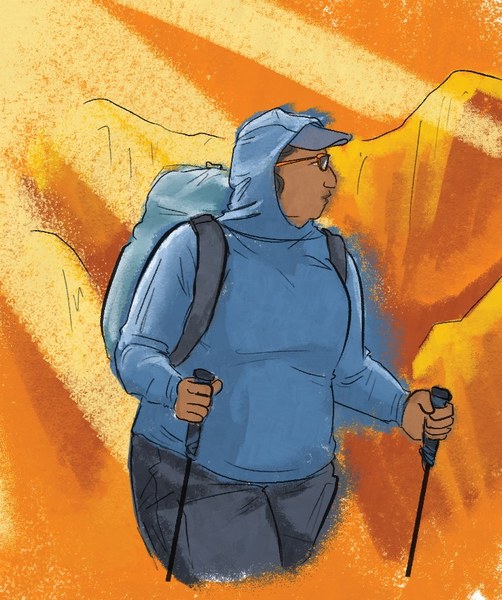
Team thumbholes, by Jenn Bostrom
Of all The Ten Essentials, sun protection hasn’t always been top of mind. Though, a four-day backpacking trip in the High Sierra quickly changed my tune. I packed my Ten Essentials, including my bottle of trusty SPF 30, threw my sun hoodie in the bottom of my pack, wore my cute tank, and topped it all off with a trucker hat. I made it a mile before it felt like my skin was being seared off. I was sweaty and greasy, which only made me feel hotter. The sun’s glare through the sides of my glasses gave me a headache. Misery doesn’t begin to describe how I was feeling. Luckily, my guide took notice. Tanya patiently got me rehydrated, then took stock of my sun protection setup. She insisted I wear my sun hoodie, showed me how to anchor the front of the hood to my trucker hat, and even shared her chewable electrolytes and zinc and titanium super SPF. I took it one step further and insisted on using my thumbholes. The exposure and elevation of this trip tested me in ways I didn’t expect. Now I never leave for an adventure without proper sun protection for myself or my kids. Sun protection is not a just-in-case but an always Essential.
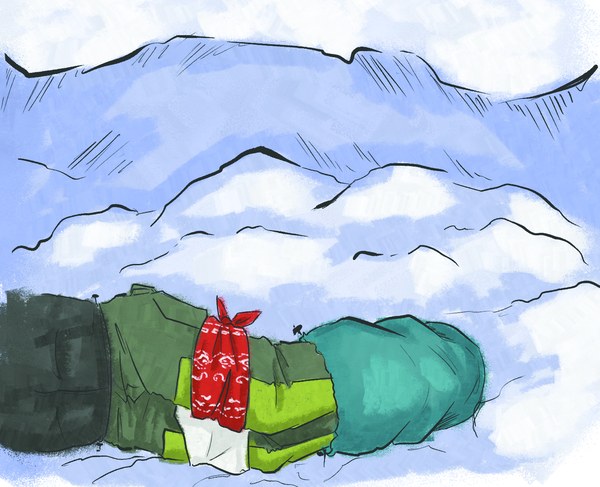
The bivy left behind, by Jerry Stein
In 2020, Sue Shih, Drew Eliott, Rochelle Garcia, and I set off on a scramble of Kimtah and Cosho Peaks via Easy Pass in the North Cascades. The plan was to ascend a gully to Ragged Ridge, traverse east to Kimtah, come back and traverse to Cosho, and descend. In case we didn’t return to camp before dark, we each packed a sleeping bag and overnight gear for a possible bivy. We reached a notch 900 vertical feet below the ridge crest between Cosho and Kimtah. Thinking we’d surely get back this far before dark, most of us stashed our overnight gear. The scramble to the ridge and traverse to Kimtah took longer than expected. After summiting, we moved quickly toward Cosho, making it back to the saddle as it became dark. Our overnight gear was 900 feet of loose rock and scree below. We felt it would be better to sleep at the saddle than to descend by headlamp. I found a depression near the breezy ridge crest, emptied my pack, and put on all my layers. My torso was passably comfortable, with a down puffy over a vest and a shirt. For my legs, I only had rain pants over hiking pants over boxers. For additional warmth, I put my legs in my pack. But my thighs were still exposed, proving too cold for sleep. I tied a bandana around one thigh, and a triangular bandage from my first aid kit around the other. I slept fitfully in 40-degree temps and woke to beautiful views of Mt. Logan across the valley. We made it back to our gear, and Sue and I scrambled up another gully to tag Cosho… But that’s a story for another day.
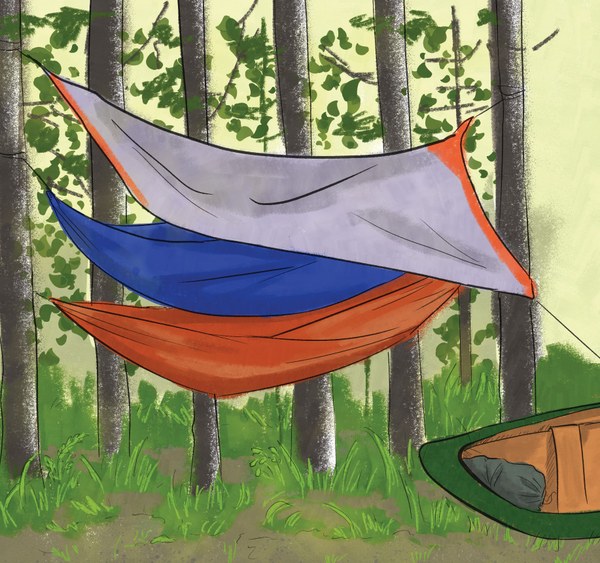
When in doubt, double check, by Phillip Haggith
A few years ago, I had the entertaining opportunity to take friends - Ben and Holly - on a canoe camping excursion. We loaded up the canoes with gear and plopped them into the still waters of Baker Lake. Then, began our paddle north. After some time gliding through the still water, the wind picked up and clouds rolled in. Rain was upon us. It continued to rain for the remainder of the excursion. After six miles, we arrived cold and wet, excited to set up camp and be in the dry. Unpacking our gear, it didn’t take long for Ben and Holly to realize they forgot a quintessential camping component: their tent. The only viable substitute was two hammocks and a spare tent footprint. We strung the hammocks one above the other and used the footprint as a makeshift rain fly. After some back and forth on who would take top bunk, Ben and Holly settled in for the night. They didn’t sleep solo for long. The cold was so intense, Holly crawled into her partner’s hammock in the middle of the night, desperate for warmth. In the morning, Ben and Holly silently began packing up their makeshift shelter, eager to return home. I started loading the canoe, and was taken by surprise when I saw a small bag tucked into the corner of the bow. As I got closer, I realized this wasn’t just anybag. This was Ben and Holly’s seemingly forgotten tent. I hid it amongst our other gear, loaded up the rest of our belongings, and we were off. To this day, Ben and Holly have no idea their painfully chilled night was in vain.
This article originally appeared in our fall 2024 issue of Mountaineer magazine. To view the original article in magazine form and read more stories from our publication, visit our magazine archive.
 Bayley Stejer
Bayley Stejer
